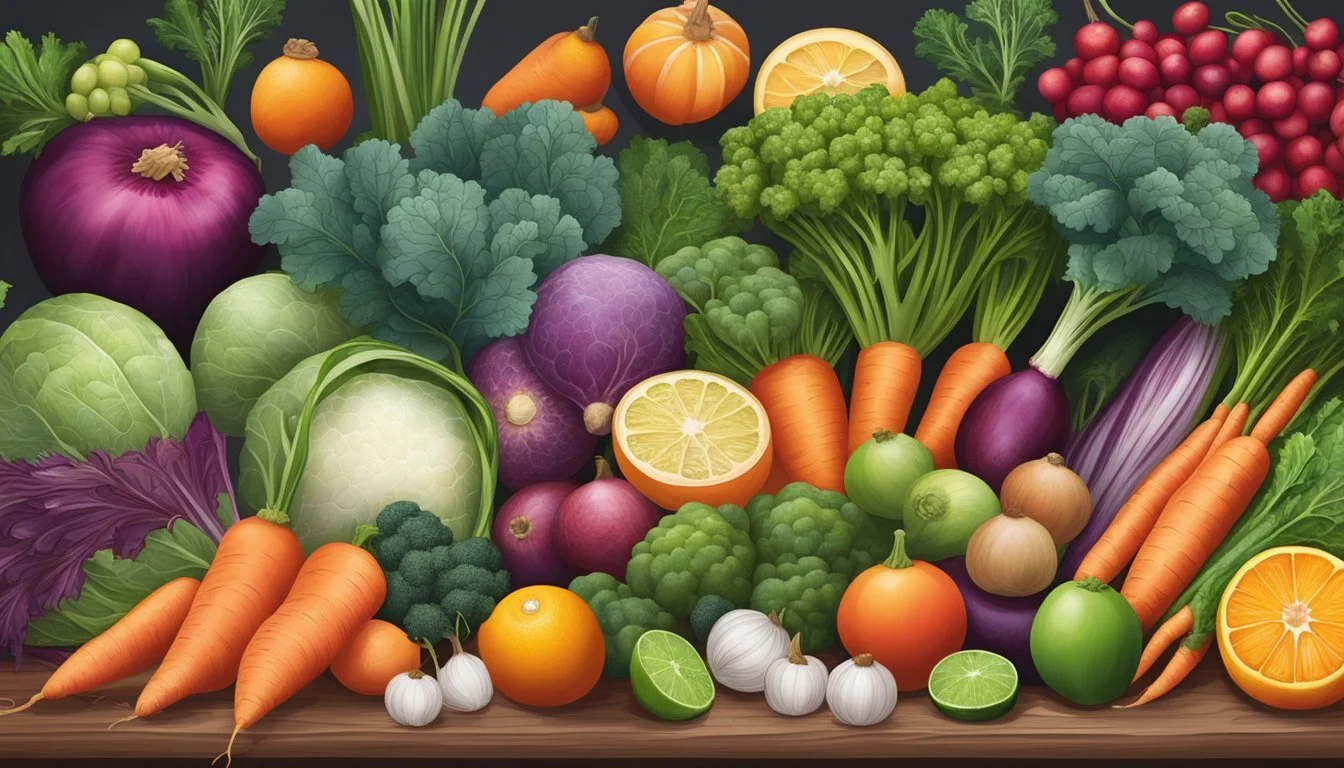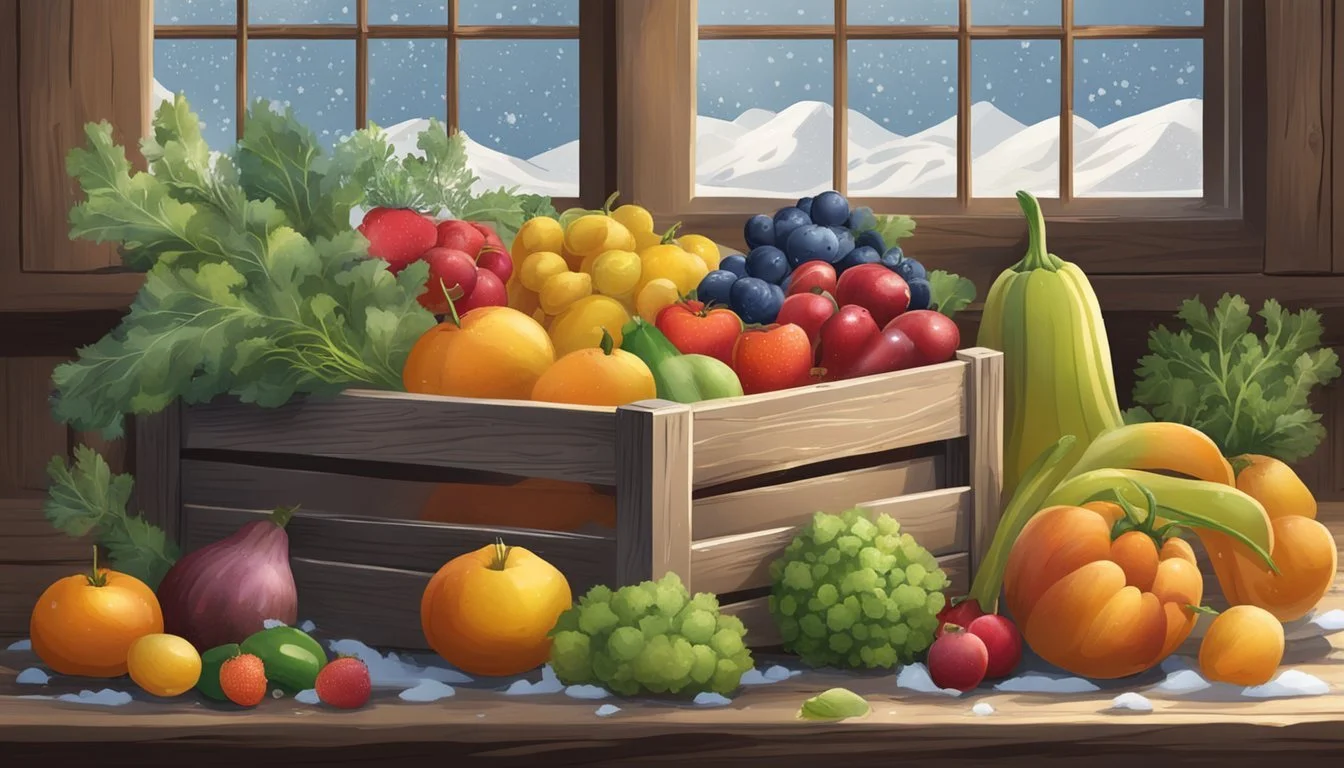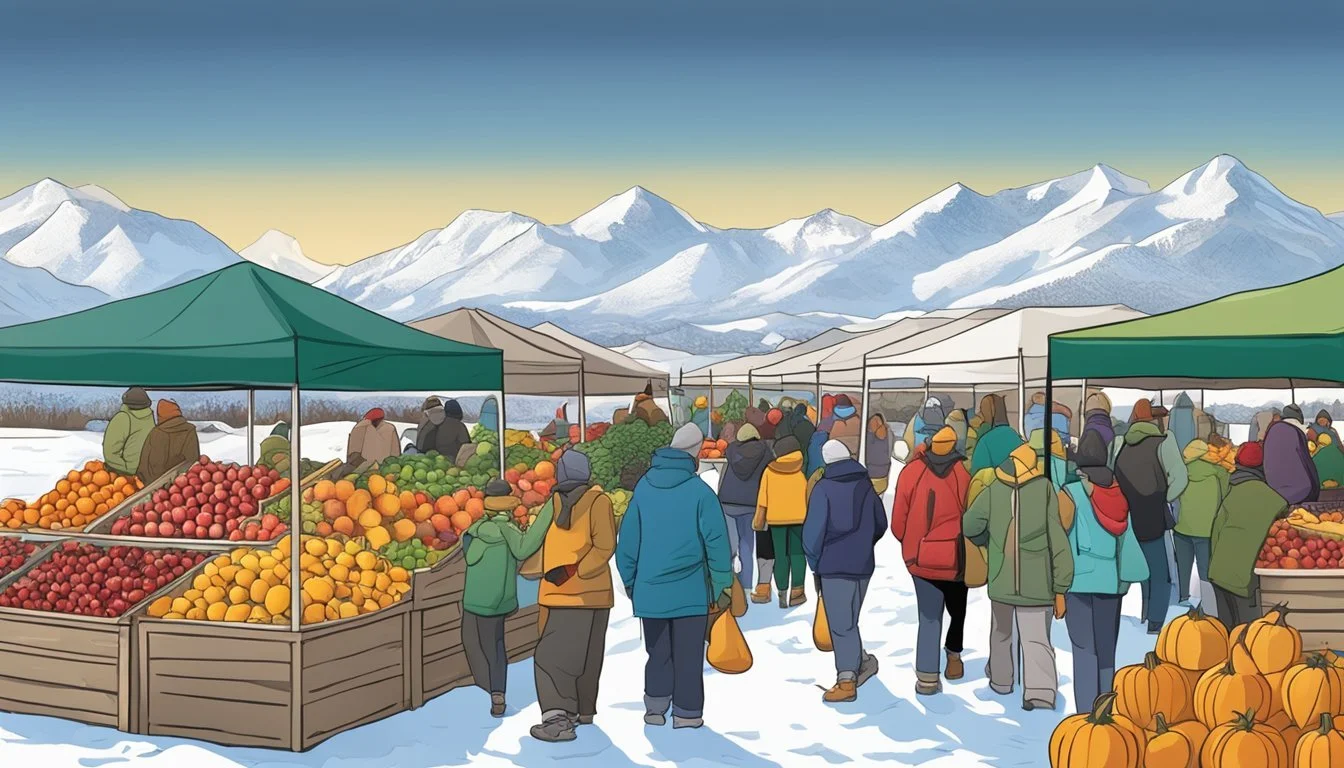Nevada Seasonal Fruit & Vegetables in December
A Winter Produce Guide
This Article is Part of our Nevada Seasonal Fruit & Veg Calendar
Nevada, with its diverse climate ranging from arid desert to cooler mountain regions, offers a unique array of seasonal fruits and vegetables that shift throughout the year. In December, the state’s agricultural focus turns predominantly towards cold-hardy crops and stored produce from earlier harvests. Consumers seeking fresh, local produce during this time will find a selection that differs from the abundance available in the warmer months.
Seasonal eating in December in Nevada leans towards root vegetables and hearty greens, which are capable of withstanding the chillier temperatures. Among the offerings, individuals can usually find robust vegetables like beets (how long do beets last?), which have been harvested from July through October and often stored for winter use. Green leafy vegetables, such as curly endive and escarole, are at their best in the fall and winter months, making them a common sight in December’s farmers markets across Nevada.
While the winter season in Nevada is not known for its fruit harvests, certain berries like cranberries, which are harvested in the fall, continue to be available fresh into December due to their longer shelf life. These fruits and vegetables, along with imported citrus to supplement the local yield, provide Nevadans with a modest yet nutritious variety to adorn their tables during the winter season.
Overview of Nevada's Winter Produce
In Nevada, winter brings a limited yet diverse range of fruits and vegetables that can withstand the cooler climate. The seasonality of produce is influenced by Nevada's unique desert environment, which encompasses regions of varying altitudes and climatic conditions.
Winter Fruits: While the fruit selection is narrower during winter, residents rely on stalwarts like persimmons and late apples that are stored from fall. Citrus fruits, though not typically grown in Nevada due to the climate, are often imported and enjoyed during these months.
Winter Vegetables: Vegetables tend to be heartier, with winter squash being a prominent choice due to its hardy nature and storage potential. Root vegetables also thrive in the cold, providing a nutritious selection that includes:
Carrots (how long do carrots last?)
Beets
Turnips
Greens also persist through the Nevada winter, though with reduced variety. Kale (What wine goes well with kale?) and spinach are often available due to their cold-resistant qualities.
Month Produce December Winter Squash Kale Carrots Spinach Beets Apples Persimmons
These winter offerings are featured at local farmers markets and are indicative of Nevada's adaptive agriculture. Residents utilize seasonal produce to create warming dishes that reflect the regional pallet and the resilience of desert farming.
Fruits Available in December
During December in Nevada, the availability of fresh fruits tends to focus primarily on hearty citrus varieties, resilient pome fruits, and a selection of berries and other fruits that can be sourced due to their late harvest times or storage capabilities.
Citrus
Oranges: They are a staple in December, providing a fresh, vitamin C-rich option during Nevada's winter months.
Lemons: Also sourced from outside the state, lemons complement the citrus selection with their tangy flavor.
Pome Fruits
Apples: Various apple varieties remain crisp and sweet during December, having been stored post-harvest to extend their availability.
Pears: Pears, like apples, are often enjoyed in their peak ripeness and are commonly found in markets during this time.
Other Seasonal Berries and Fruits
Persimmons: This unique fruit is available in December, offering a rich, honey-like flavor.
Pomegranates: Known for their jewel-like seeds and deep, sweet-tart flavor, pomegranates are another seasonal favorite.
Vegetables to Enjoy in December
December in Nevada brings cooler temperatures and a perfect environment for a variety of vegetables, especially leafy greens, robust root vegetables, and hearty cruciferous selections. This selection offers a fresh, nutritious complement to winter meals.
Leafy Greens
In December, one can enjoy a bounty of leafy greens. Kale and spinach, known for their nutrient-dense profiles, are among the readily available greens.
Kale: Full of vitamins A, K, and C.
Spinach: Rich in iron and magnesium.
Root Vegetables
The soil yields an excellent harvest of root vegetables during this time. Vegetables such as potatoes, beets, carrots, radishes, and turnips are not only great for their storability but are also versatile in the kitchen.
Potatoes: A staple with wide culinary use.
Beets: Deeply colored, sweet, and earthy.
Carrots: Crunchy and packed with beta-carotene.
Radishes: Distinctive peppery flavor.
Turnips: Can be eaten raw or cooked, with a slightly bitter taste.
Cruciferous Vegetables
Cruciferous vegetables like brussels sprouts, cabbage, broccoli, and cauliflower thrive in the chill of December. They provide robust flavors and are packed with fiber and other essential nutrients.
Brussels Sprouts: Small but filled with cancer-fighting compounds.
Cabbage: Offers a combination of vitamins C and K.
Broccoli: High in fiber and protein.
Cauliflower: A lower-calorie alternative to grains and legumes.
Buying Local: Farmers Markets and Stores
In December, residents of Nevada can find a range of produce by visiting local farmers markets and specialty stores. Though the selection is more limited compared to other months, these venues often offer storage crops and goods from greenhouses.
Farmers Markets: They are a key source of local, fresh produce and often the nexus of community engagement. While fewer markets operate in winter, some do persist, offering seasonal produce along with other local products like honey, preserves, and baked goods. Patrons can directly support farmers and the state's agricultural economy by shopping at these markets.
At Local Stores: Many stores in Nevada prioritize stocking produce from local farms as well. Root vegetables and some leafy greens are typical finds during the colder months, sourced from regional growers.
Typically Available Produce:
Root Vegetables: Carrots, beets, and potatoes
Leafy Greens: Kale and spinach from protected cultivation
Winter Squash: Stored from the fall harvest
Apples: From cold storage, having been picked in the fall
For the most current information, shoppers should check online resources or contact the markets directly to confirm their December dates and available produce. The Nevada Department of Agriculture's website can also provide guidance on finding farmers markets, their schedules, and the range of products available during the winter season.
Health Benefits of Seasonal Eating
Eating seasonally offers numerous nutritional benefits that contribute to overall health. When consumers choose seasonal fruits and vegetables, they are selecting produce that is likely harvested at its peak ripeness. This not only enhances flavor but also ensures a higher concentration of vitamins, minerals, and antioxidants. For example, seasonal winter produce in Nevada such as squash, root vegetables, and leafy greens are packed with essential nutrients.
Nutrient Density: Seasonal fruits and vegetables have a higher nutrient density due to their peak harvesting time. They haven't been stored for long periods, which can deplete their vitamin and mineral content.
Enhanced Flavor: Fresh produce's flavor is at its best when it's in season, making meals more enjoyable and potentially increasing one's intake of fruits and vegetables.
Immune Support: With winter comes the need for immune support. Seasonal produce like pumpkin, rich in vitamins and minerals, can boost immunity and may play a role in liver cleansing.
Seasonal eating also encourages dietary variety, which is essential for obtaining a range of nutrients throughout the year. Rather than relying on the same set of produce, consumers can enjoy a diverse array of fruits and vegetables that align with the changing seasons.
Variety in Diet:
Winter: Consuming squash and root vegetables.
Spring: Leafy greens and asparagus.
Summer: Berries and stone fruits.
Fall: Apples and pomegranates.
By opting for seasonal eating, individuals can enjoy foods when they are most nutritionally potent and contribute to a sustainable food economy. It supports local farming and reduces the environmental impact associated with transporting out-of-season produce long distances.
How to Store and Prepare
In the cold month of December in Nevada, proper storage and preparation of seasonal produce can maintain freshness and enhance flavors. When it comes to winter favorites like potatoes and winter squash, knowing the right techniques is key for enjoyable and nutritious meals.
Storage Tips
Cool and dark: Store them in a cool, dark place with good air circulation to prevent sprouting.
Avoid moisture: Keep them away from moisture as it can lead to decay.
Winter Squash:
Room temperature: Store winter squash at room temperature in a well-ventilated area, away from direct sunlight.
Check regularly: Inspect for signs of soft spots or mold, which indicate they should be used promptly or discarded.
Preparation Ideas
Potatoes:
Baking: For a crispy skin and fluffy inside, bake potatoes at a high temperature, such as 425°F (218°C), until tender.
Roasting: Cut potatoes into even pieces, toss with oil and seasonings, and roast until golden.
Soups: Cube potatoes and add to soups for a hearty texture.
Winter Squash:
Roasting: Halve the squash, remove seeds, and roast cut-side down to concentrate the natural sugars and flavors.
Baking: Bake winter squash in the oven, seasoned or stuffed, as a flavorful side dish.
Soups: Puree roasted winter squash to create smooth, creamy soups with a rich taste.
Careful storage extends the life of these seasonal commodities, while thoughtful preparation allows their natural flavors to shine in warming, winter-time dishes.
Understanding Seasonal Food Data
When scrutinizing the data on seasonal foods, especially in Nevada for the month of December, the emphasis is on the availability of locally grown produce. Seasonal patterns in agriculture profoundly influence the variety of fruits and vegetables that come to market. Nevada’s climate, predominantly desert with cold winters, means certain crops thrive in December, while others are out of season.
Data collected from farmers, agricultural reports, and Nevada's agricultural zone information provides insight into what is typically harvested during this month. There's a notable shift to root vegetables and hearty greens which withstand colder temperatures. For example:
Root Vegetables:
Beets
Carrots
Hearty Greens:
Collard Greens (how long do collard greens last?)
Kale
Agriculture in Nevada adapts to seasonal changes by utilizing greenhouses, cold storage, and different harvesting techniques to extend the availability of certain produce. While data shows that fruits are sparser in December, buyers might still find storage apples and winter squashes, reflective of the post-harvest abundance.
The information underlines the importance of understanding the seasonal availability and consumption patterns. Eating seasonally supports local agriculture and ensures that consumers receive produce at peak freshness and nutritional content. This practice can also have environmental benefits, reducing the footprint associated with long-distance transportation.
Produce data serves as a guide for both consumers and retailers, streamlining the farm-to-table process and affirming the seasonal rhythms of food production in Nevada. Thus, knowing what is in season is not only beneficial for health but also for supporting regional farmers and sustainable practices.









